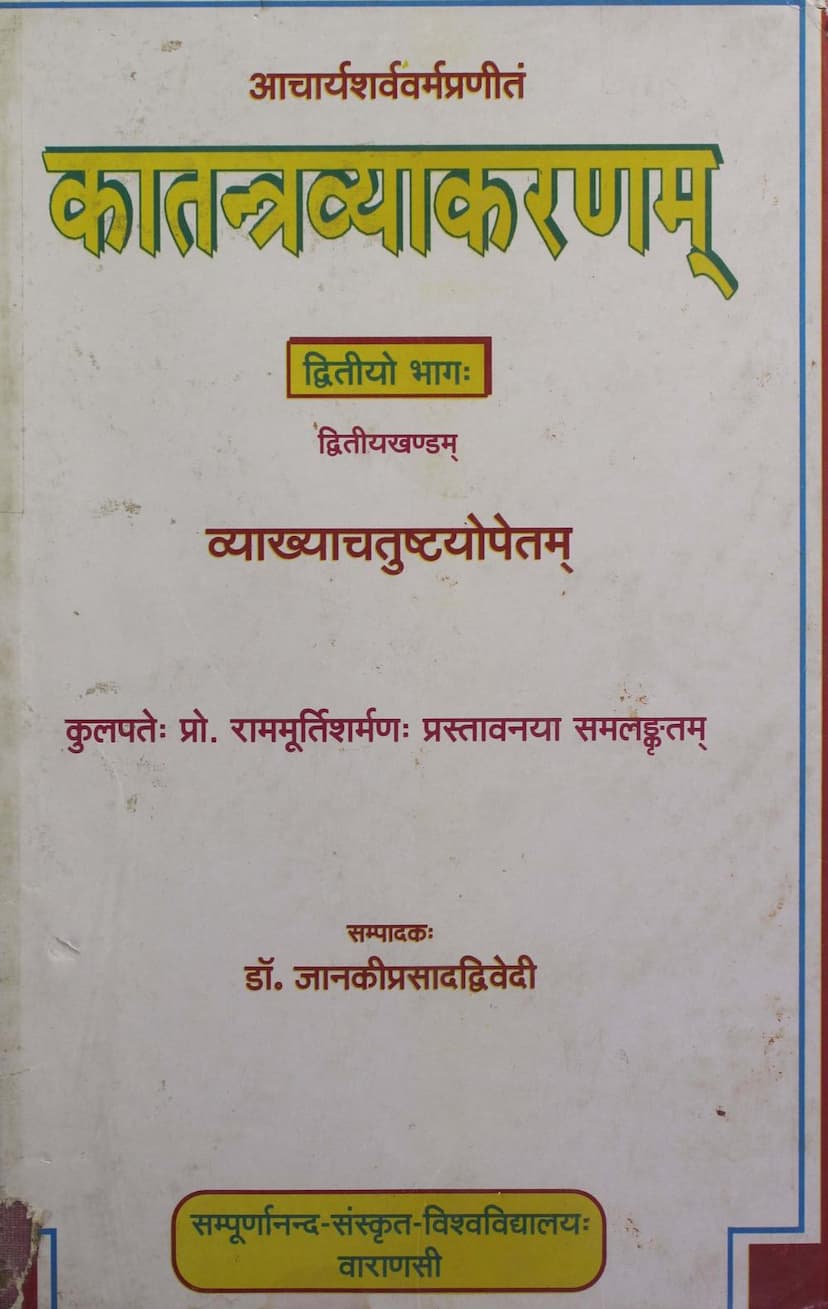Katantra Vyakaranam Part 02 Khand 02
Added to library: September 2, 2025

Summary
This comprehensive summary covers the content of "Katantra Vyakaranam Part 02 Khand 02" by Jankiprasad Dwivedi, published by Sampurnanand Sanskrit Vishva Vidyalay. The book focuses on the Katantra Vyakarana of Acharya Sarva Varma, specifically the second part, second section. It includes four commentaries: 'Vritti' by Shri Durga Singh, 'Kātantravṛttipañjikā' by Shri Trilochanadas, 'Kalāpacandra' by Kaviraja Suṣeyasarma, and 'Samīkṣā' by the editor. The foreword is by Prof. Rammurti Sharma, Vice-Chancellor of Sampurnanand Sanskrit University.
Here's a breakdown of the content:
Overall Structure and Content:
The book is a detailed analysis and edition of the second part, second section of the Katantra Vyakarana. This section covers Chapters 8 to 10 of the Katantra, which deal with Karaka (case relations), Samasa (compounding), and Taddhita (secondary suffixes). The work is presented with extensive editorial commentary, referencing other important Sanskrit grammatical traditions like Paninian grammar and Prātisākhyas, as well as comparative studies.
Key Themes and Sections:
-
Foreword by Prof. Rammurti Sharma: The foreword highlights the significance of the Katantra Vyakarana for its brevity and clarity, noting its widespread influence not only in India but also in Tibet, Nepal, Bhutan, and Sri Lanka. It also commends the editor, Dr. Janaki Prasad Dwivedi, for his meticulous work in bringing out this volume with four commentaries. The foreword acknowledges the Jain connection to the Katantra and mentions the editor's awards for his contributions to Jain grammar.
-
Introduction by Dr. Janaki Prasad Dwivedi:
- The introduction provides a detailed overview of the Katantra Vyakarana, its author Acharya Sarva Varma, and its various names (Kalāpa, Kaumāra, Śarvavarmika, Daurgasiṁhīya).
- It explains the structure of the second part, which consists of six chapters (pādas), and the specific content of this volume: Karaka (case relations), Samasa (compounding), and Taddhita (secondary suffixes).
- A significant portion of the introduction is dedicated to a comparative analysis of Katantra rules with those of Paninian grammar (Pāṇinīya Vyakaraṇa). It points out similarities and differences in their approaches to various grammatical phenomena, including:
- Samāsa saṁjñā (names of compounds)
- Vibhakti lopa (loss of case endings)
- Prakṛti bhāva (stem nature)
- Vyanjana (consonant) rules
- Nuga-āgama (addition of 'nu')
- Pratyaya ādeśa (change of suffixes)
- Specific rules for nañ-samāsa (negation compounds)
- The introduction also discusses specific points from the commentaries of Durga Singh, Trilochanadas, Suseyasarma, and the editor, highlighting their interpretations and discussions on various grammatical topics.
- It mentions the rich manuscript tradition of the Katantra, with texts found in various scripts and languages, including Tibetan translations and commentaries.
-
Commentaries and Analysis: The book meticulously edits and analyzes the Katantra text, providing:
- Original Sutras: The original Sanskrit sutras of the Katantra are presented.
- Commentary Excerpts: Detailed explanations and discussions from the four commentaries are integrated, often presenting differing views of various Acharyas.
- Comparative Study: Frequent comparisons are made with Paninian grammar, highlighting the unique aspects and advantages of the Katantra.
- Analysis of Specific Topics: The introduction and the commentary discuss in detail:
- Karaka (Case Relations): The book delves into the rules governing Apādāna (ablative), Sampradāna (dative), Adhikaraṇa (locative), Karaṇa (instrumental), and Karma (accusative) cases, comparing Katantra with Pāṇini.
- Samasa (Compounding): Various types of compounds like Karma-dhāraya, Dvigū, Tātpuroṣa, Bahuvrīhi, and Dvandva are discussed, with attention to their formation rules and differences from Paninian grammar.
- Taddhita (Secondary Suffixes): A significant portion deals with various secondary suffixes, their application, and derivation of words, again with comparative notes.
-
Appendices (Parishishta): The book includes extensive appendices that are crucial for scholarly research:
- List of Sutras: Citations and summaries of sutras from Katantra Parishishta of Shripatidatta related to Karaka, Stripratyaya (feminine suffixes), and Samasa.
- Rūpasiddhi (Word Formation): An alphabetical list of 757 words with their grammatical derivations.
- Śloka Index: A collection of 250 verses quoted in the commentaries.
- Etymological Vocabulary: A list of 749 words with their etymological explanations.
- Technical Terms: A glossary of 147 technical terms used in the commentaries.
- Specific Word Collection: A compilation of 1386 specific words and phrases, offering insights into grammatical processes, usage, and style.
- Bibliography: A list of 77 quoted texts and 112 authors.
- Manuscript and Printed Text Catalog: An introduction to manuscript and printed texts related to Katantra.
- Index of Abbreviations: An introduction to symbolic terms.
Key Takeaways:
- Emphasis on Laaghava (Brevity and Simplicity): The Katantra Vyakarana is praised for its concise rules, which make it easier for learners. The editor highlights how Katantra often achieves the same results as Panini with fewer rules or simpler explanations.
- Comparative Grammar: The book is a valuable resource for comparing Pāṇinīya Vyakaraṇa with Katantra Vyakarana, revealing the distinct methodologies and philosophies of these two great grammatical traditions.
- Scholarly Rigor: The extensive introduction, detailed analysis of sutras, comprehensive appendices, and inclusion of multiple commentaries showcase the scholarly depth and commitment to presenting a definitive edition.
- Jain Heritage: The introduction and foreword acknowledge the strong connection between the Katantra and Jain scholars, who played a vital role in its preservation and propagation.
In essence, this volume is a monumental work of scholarship that provides a deep dive into a significant but less widely studied grammatical tradition within the vast landscape of Sanskrit linguistics. It is an essential reference for scholars and students of Sanskrit grammar, particularly those interested in the Katantra tradition and its unique contributions.